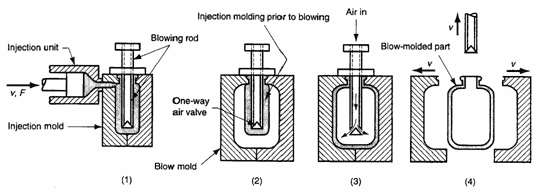Blow molding is accomplished in two steps: (1) fabrication of a starting tube of molten plastic, called a parison (same as in glass-blowing); and (2) inflation of the tube to the desired final shape. Forming the parison is accomplished by either of two processes: extrusion or injection molding.
Extrusion Blow Molding. This form of blow molding consists of the cycle illustrated below. In most cases, the process is organized as a very high production operation for making plastic bottles. The sequence is automated and usually integrated with downstream operations such as bottle filling and labeling. It is usually a requirement that the blown container be rigid, and rigidity depends on wall thickness among other factors.
Extrusion blow molding: (1) extrusion of parison; (2) parison is pinches at the top and sealed at the bottom around a metal blow pin as the two halves of the mold come together; (3) the tube is inflated so that it takes the shape of the mold cavity; and (4) mold is opened to remove the solidified part.

Injection Blow Molding. In this process, the starting parison is injection molded rather than extruded. A simplified sequence is outlined in below. Compared to its extrusion-based competitor, the injection blow-molding process has a lower production rate, which explains why it is less widely used.

Injection blow molding: (1) parison is injection molded around a blowing rod; (2) injection mold is opened and parison is transferred to a blow mold; (3) soft polymer is inflated to conform to a blow mold; and (4) blow mold is opened and blown product is removed.
In a variation of injection blow molding, called stretch blow molding (see below), the blowing rod extends downward into the injection molded parison during step 2, thus stretching the soft plastic and creating a more favorable stressing of the polymer than conventional injection blow molding or extrusion blow molding. The resulting structure is more rigid, with higher transparency and better impact resistance. The most widely used material for stretch blow molding is polyethylene terephthalate (PET), a polyester that has very low permeability and is strengthened by the stretch-blow-molding process. The combination of properties makes it ideal as a container for carbonated beverages.

Stretch blow molding: (1) injection molding of the parison; (2) stretching; and (3) blowing.
Materials and Products. Blow molding is limited to thermoplastics. Polyethylene is the polymer most commonly used for blow molding; in particular, high density and high molecular weight polyethylene (HDPE and HMWPE). In comparing their properties with those of low density PE given the requirement for stiffness in the final product, it is more economical to use these more expensive materials because the container walls can be made thinner. Other blow moldings are made of polypropylene (PP), polyvinylchloride (PVC), and polyethylene terephthalate.
Disposable containers for packaging liquid consumer goods constitute the major share of products made by blow molding; but they are not the only products. Other items include large shipping drums (55 gallon) for liquids and powders, large storage tanks (2000 gallon), automotive gasoline tanks, toys, and hulls for sail boards and small boats. In the latter case, two boat hulls are made in a single blow molding and subsequently cut into two open hulls.


